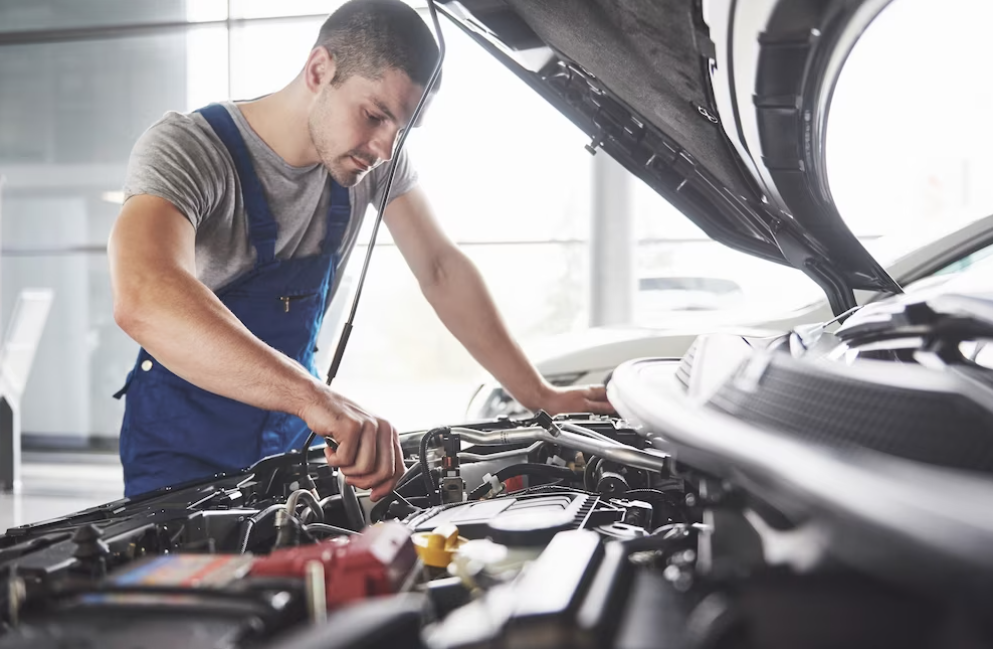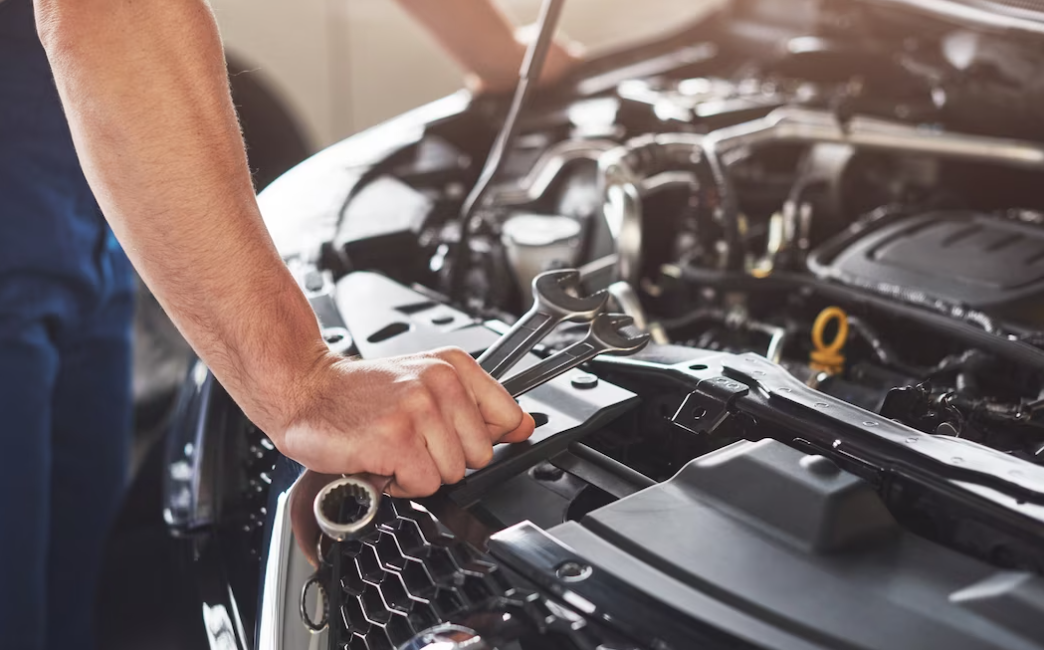While driving, you might notice an unfamiliar sound when braking at low speed. Experienced drivers may not worry, but if you’re new, it could be concerning. Don’t panic; these issues are common, especially for regular drivers.
Differentiating Noises When Braking at Low Speeds
When braking at low speeds, you might encounter various noises, each potentially indicating different problems with your braking system. Identifying these noises accurately can help streamline the repair process and address issues promptly.
Grinding Noise:
A grinding noise while braking is a cause for serious concern, indicating potential severe issues within the brake system. Typically, it results from worn brake pads grinding against the rotors, posing a risk of significant damage to the rotors and calipers. Ignoring this noise can lead to further damage and even brake failure. If you experience grinding noise at low speeds, it’s crucial to avoid driving and promptly have the issue checked and repaired.
Squeaking:
Though not as damaging as grinding noises, squeaking sounds can still be bothersome and problematic. They often arise from low-quality brake pads containing metal flakes, creating a squeaking or scraping sound when in contact with the rotors. This can negatively affect the brake rotors over time. If you encounter squeaking noises while braking, it’s advisable to inspect the quality of your brake pads and consider upgrading to higher-quality ones.
Additionally, worn brake pads can also produce similar sounds, and the brake wear indicator can help you determine when it’s time to replace them.
Squealing Noise:
Squealing noises are typically caused by rust buildup on the brake rotors, especially after parking the car in wet or moist areas for extended periods. When the rust interacts with metal during braking, it generates the squealing noise at low speeds.
If you notice a squealing noise after your car has been parked unused for some time, there’s no immediate cause for concern. Simply applying the brakes a few times will gradually clear the rust, and the squealing noise will eventually fade away.
Identifying the Sources of Noise When Braking at Low Speed
Having learned how to distinguish various noises, it’s essential to understand their underlying causes. To address the issue and silence the brake noises, identifying the root cause is crucial. Let’s explore some common reasons behind the noises you may experience while braking at low speed.
Worn-Out Brake Pads
One of the most common causes of noise when braking at low speeds is worn-out brake pads. Brakes operate by generating friction, and over time, this friction wears down the brake pads.
Brake pads are composed of a combination of elements such as copper, graphite, and iron. This layer is the part that makes contact with the rotor, creating the necessary friction to slow down the vehicle. As the brake pads wear down, the outer metal cover eventually comes into contact with the rotor.
The sound you hear when the outer metal layer contacts the rotor is quite distinct, often resulting in a squeaking noise. Additionally, many modern vehicles have built-in indicators that light up when the brake pads are excessively worn. It’s important to note that the brake pads are the only components designed to come into direct contact with the rotors.
When the metal surface comes into contact with the rotor, there is a risk of damaging the rotor itself. Consequently, neglecting to replace the worn-out brake pads in a timely manner may lead to the need for rotor replacement as well. Therefore, it is crucial to address worn-out brake pads promptly to avoid potential damage and ensure safe and efficient braking performance.
Dirt And Debris
Due to their proximity to the road, car brakes are constantly exposed to various impurities. While protective covers do their best to shield the brake components, some foreign particles manage to find their way through.
These intrusive particles often become lodged between the brake pads and the rotors. When the brakes are engaged, these particles come into contact, resulting in an unusual noise during braking.
The size and nature of the particles can vary, leading to different types of noises being emitted. As a result, it’s challenging to pinpoint the exact type of noise that may arise. Drivers may hear grinding, squeaking, or squealing noises when braking at low speeds.
Fortunately, not all instances of noise from impurities require brake pad replacement. A possible solution is to disassemble the brakes and thoroughly clean the affected components, which can help alleviate the noise and restore proper brake function. By doing so, you may avoid the need for immediate brake pad replacement and ensure smoother, quieter braking performance.

Worn-Out Rotors
Several maintenance errors can lead to the deterioration of your car’s rotors. Using low-quality brake pads or continuing to use worn-out brake pads can result in scratching and damaging the rotor disks.
Over time, this wear and tear affect the surface of the rotor, causing it to lose its flatness. Consequently, engaging the brakes with worn-out or damaged rotor disks can produce squeaking sounds.
Another way rotors can be damaged is during the process of cleaning your car. Brakes generate significant heat during driving, and attempting to wash your car with cold water may lead to rapid temperature changes that can harm the rotor.
The specific kind of damage your rotors might sustain is challenging to predict. As a consequence, when braking at low speeds, you may hear unusual noises and experience vibrations, indicating potential rotor issues.
To avoid these problems, it’s crucial to maintain your brake system properly, including using quality brake pads and replacing worn-out pads promptly. Additionally, take care when cleaning your vehicle to prevent sudden temperature changes that could harm the rotors. By addressing maintenance concerns promptly, you can ensure the longevity and optimal performance of your car’s braking system.
Brake Pad Material
Since the advent of automobiles, brake pads have undergone continuous development, utilizing a diverse range of materials. These pads must endure extreme temperatures, reaching up to 600 to 700 degrees Celsius or 1100 to 1300 degrees Fahrenheit during braking.
The ability to withstand such scorching temperatures is crucial for brake pads. However, finding the perfect material has been a challenging endeavor, leading to numerous experiments with different substances. In the past, materials like asbestos, kevlar, ceramic, and metal blends were among the candidates for brake pads.
Today, with the exception of asbestos, brake pads crafted from other materials are readily available. Each material produces distinct sounds when in use. Notably, kevlar and ceramic pads are known for generating considerably less noise compared to other brake pad materials.
If you recently switched to a different brake pad material, it’s possible that you may notice noise when braking at low speeds. This variation in noise levels highlights the importance of selecting suitable brake pad materials for optimal performance and reduced noise during braking.
Damaged Shims
Shims serve as thin rubber strips or metal adhesive placed between the caliper and the brake pads, specifically designed to reduce the noise produced during braking. However, over time, these shims can become damaged or worn out.
When the shims fail to function as intended, you may notice an increase in the usual braking noise. Additionally, if your shims are made of metal, you might experience grinding noises. This occurs when the metal shims come into contact with the rotor, resulting in a distinct grinding sound caused by the metal-on-metal friction.
To ensure a quieter and smoother braking experience, it’s essential to replace your shims when they become worn out or damaged. By maintaining well-functioning shims, you can minimize brake noise and enjoy a more pleasant driving experience.
Lack Of Lubrication
In a friction-based system like the brakes, you may wonder about the relevance of lubrication. While the primary components of the braking system do not require lubrication, there are specific parts within the system that do.
In particular, the caliper screws and bolts are components that benefit from proper lubrication. Regular lubrication of these parts is essential to ensure smooth operation and prevent issues.
Without sufficient lubrication, these components can generate grinding or squeaking noises when braking at low speeds. To avoid such problems, it is crucial to apply lubrication as needed to the caliper screws and bolts, maintaining a well-functioning braking system and providing a quieter and more comfortable driving experience.
Rust
Given the numerous metal components in the braking system, rust can pose a significant concern. Rust formation can occur anywhere within the system, leading to potential issues for your car.
One common consequence of rust is its presence on the brake rotors, which can cause disruptions in braking performance. Leaving your car parked in a moist or wet environment for an extended period can contribute to the buildup of rust on the rotors.
When rust accumulates on the rotors, you may hear a noticeable squealing noise when applying the brakes. Fortunately, as the brake pads engage with the rotors, they help clear away the rust through the scrubbing action.
To ensure smooth and efficient braking, it’s important to address rust concerns promptly. Regular maintenance, keeping your vehicle parked in dry areas, and using the brakes regularly can help minimize rust buildup and preserve the overall braking performance of your car.
How to Fix Car Noise

There are limited ways to address faulty brakes, and even though the noise can help narrow down the potential issues, it’s crucial to get the brakes repaired. One common cause of unusual noises is worn-out brake calipers, and the most effective approach to tackle this is through a physical inspection. Begin by removing the tires and carefully examining the brake pads. Concurrently, inspect the rotors for any signs of wear or damage. If there are no visible issues, you can breathe easy.
Next, proceed to inspect the shims, although damaged shims are a rare occurrence. If any damage is spotted, they should be promptly replaced. Additionally, lubricate the caliper screws and bolts if necessary.
Now that the inspection is complete, it’s time to focus on resolving the noise issue. If any of the components are found to be faulty during the inspection, make sure to replace them accordingly.
However, if all the components seem to be in good condition and no signs of wear or damage are observed, the problem may be attributed to loose parts. To confirm this, try gently wiggling the components by hand. Ideally, there should be no movement when you attempt to wiggle them. If there is any play, you need to tighten those components.
Loose parts can lead to unusual noises, especially when braking at low speeds. If you have already disassembled the brake pads, take the opportunity to clean them thoroughly, ensuring no dirt or debris is stuck on them.
As you reassemble the brake system, consider applying dampening paste. This water-based compound effectively reduces vibrations, providing an effective solution for minimizing noises during braking.
After applying the paste, allow it to dry for 2 to 3 hours before reassembling the brakes. This should successfully address the problem of noise when braking at low speeds. However, if the issue persists, it’s best to seek assistance from a professional brake specialist to ensure a thorough evaluation and proper resolution.
If your car is making noise when braking at low speeds, follow these steps to address the issue:
| Step | Description |
|---|---|
| Check the brake pads | Ensure brake pads’ thickness is within the recommended range by the manufacturer. Promptly replace worn-out brake pads for optimal braking performance. |
| Inspect the brake rotor | Look for signs of wear, damage, rust, grooves, or warping on the brake rotor. Replace a damaged or worn rotor to prevent potential braking issues. |
| Clean the brake components | Use brake cleaner to thoroughly clean brake pads, calipers, and rotor. Removing dirt and debris ensures smooth and efficient brake operation. |
| Check the brake caliper | Verify the brake caliper’s proper functioning and even wear of brake pads. If it’s sticking or faulty, replace the caliper to maintain safe braking. |
| Check for worn or damaged brake lines | Examine brake lines for wear or damage. Replace any leaking or problematic brake lines to preserve the integrity of the brake system. |
How to Properly Maintain Your Brakes
Maintaining your brakes in optimal condition is crucial for safe driving. Proper upkeep not only extends the lifespan of brake components but also saves money in the long term. Here are essential steps to maintain your brakes effectively:
- Monitor Brake Fluid: Regularly check your brake fluid levels every 3 months and top them up as needed. Additionally, replace the brake fluid every 2 years or after covering 30,000 miles;
- Monitor Brake Discs: The longevity of brake discs depends on factors such as driving style and road conditions, making it challenging to predict when they need replacement. Keep a close eye on the condition of your brake discs and replace them as necessary. Typically, brake discs last for about 100,000 miles;
- Inspect Brake Pads: Regularly examine your brake pads and have them inspected by a professional. Replace brake pads every 50,000 miles or as soon as you notice signs of wear to prevent damage to the rotors.
Conclusion
Creaking noise when braking at low speeds should never be ignored. Identifying and addressing the underlying causes promptly is crucial for your safety and the longevity of your braking system. Regular maintenance, inspections, and timely repairs will ensure a smooth and noise-free driving experience, providing peace of mind on the road. Don’t hesitate to seek professional assistance if needed, as a well-maintained braking system is essential for a secure and enjoyable driving journey.
